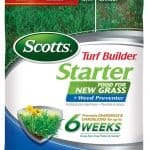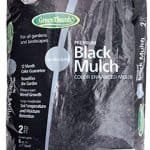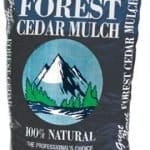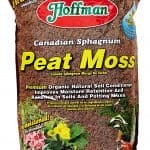Mulch is a material that is spread on the ground to protect the soil from erosion and to help maintain moisture.
Mulch can be made from organic or inorganic materials, but either way, it is a great way to keep your garden soil healthy.
It also helps keep weeds down, and blueberries are a great crop to grow in mulched soil.
In fact, mulching is one of the best things you can do for your blueberry plants.
7 Best Mulch For Blueberries Reviews
- #1. Hoffman Peat Moss For Blueberries – Best Overall
- #2. Wood Smith USA Natural Cedar Chips Mulch – Best Long Lasting
- #3. EZ-Straw Seeding Mulch For Blueberries – Best To Keep Soil Moisturized
- #4. GreenView Fairway Mulch For Blueberries – Best Mixture
- #5. Scotts Pro Fabric Mulch For Blueberries – Best Inorganic
- #6. Shannon’s Sawmill’s Premium Mixed Hardwood Sawdust Mulch – Best Acidic
- #7. Long Needle Pine Straw covering 3200 sqft – Best For Slopes
#1. Hoffman Peat Moss For Blueberries – Best Overall
 For those who are interested in the best mulch for blueberries, we vouch for the Hoffman Peat Moss.
For those who are interested in the best mulch for blueberries, we vouch for the Hoffman Peat Moss.
It offers the right combination of weed control, water retention, and pest control while keeping the cost down.
No other mulch offers this balance of features at the right retail price.
Hoffman peat moss mulch is a popular organic mulch for blueberries. It is a natural product that is high in organic matter and helps retain moisture in the soil.
Hoffman peat mulch also helps suppress weeds and promotes the healthy growth of blueberries. This mulch is a renewable resource that is produced by the decomposition of wetland vegetation.
One very important point you need to know is that it has been used in agriculture since the 1800s. That’s probably why it is also a popular mulch for blueberries.
So for these reasons, and when it comes to the best mulch for blueberries, we think peat moss is a nice option. The Hoffman-branded peat moss is one of the top quality brands on the market and we stand behind them.
In reality, a couple of inches of any organic mulch is great for blueberries, but for some reason, we find that this peat moss just works surprisingly well.
Many people like it because it strikes the right balance between keeping weeds out and water in your soil as well as making sure the pests stay out of your garden.
And it also happens to look quite nice and maintains its lush color for longer than other brands, which is another great selling point.
- Great water retention for blueberries
- Boost moisture
- Seeds free
- Look nice in the garden
- Suppress weeds
- 99.8% organic
- Perform best when mixed with perlite
- May be too acidic for non-acid-loving plants
- Low in nutrients so you need to add a fertilizer
#2. Wood Smith USA Natural Cedar Chips Mulch – Best Long Lasting
 Wood Smith USA Cedar Chips Mulch is a great way to improve the appearance of your landscaping while adding value to your property.
Wood Smith USA Cedar Chips Mulch is a great way to improve the appearance of your landscaping while adding value to your property.
The mulch is made of 100% natural western red cedar and is safe to use around plants and flowers. It is also non-toxic, which makes it perfect for use around children and pets.
The mulch can be used as a decorative ground cover, as well as a way to control weeds and slow soil erosion.
It is great at reducing moisture retention, which makes it an ideal mulch for use in the winter when temperatures are cooler.
This is why we decided to make this mulch the next up in our selection. The Wood Smith USA Natural Cedar Chips Mulch is the best mulch for blueberries if you want something that keeps the weeds out and the natural cedar scent in.
We like it because there are no chemicals or additives involved and it does a great job of absorbing moisture and unpleasant odors.
Additionally, this is a natural pest control and does a great job of making sure your soil or garden doesn’t collect root-eating pests, which can certainly spoil a nice garden.
And besides, it is a natural air freshener, which we really can’t say about other brands that can end up smelling funky over time.
- Long-lasting
- Easy to use
- Not expensive
- Environmentally friendly
- Conserve water
- Comes with a nice smell, though some may dislike it
- May decompose slowly so nutrients are not going to the soil fast enough
- A bit expensive
#3. EZ-Straw Seeding Mulch For Blueberries – Best To Keep Soil Moisturize
 If you’re looking for an easy way to improve your blueberry yields, look no further than EZ-straw seeding mulch. This simple mulch can help you get the most out of your plants, and it’s easy to do.
If you’re looking for an easy way to improve your blueberry yields, look no further than EZ-straw seeding mulch. This simple mulch can help you get the most out of your plants, and it’s easy to do.
Simply cover the soil around your blueberry plants with a layer of straw, and then use a garden seeder to plant your blueberry seeds in the straw.
The straw will protect the seeds from being blown away or eaten by animals, and it will also help to keep the soil moisture levels consistent.
So this is yet another nice product when it comes to the best mulch for blueberries. The EZ-Straw Seeding Mulch is made of premium processed straw and is completely biodegradable.
I am not going to hide it, straw mulch is commonly known as a great mulch for growing blueberries. It is quite effective at increasing yields and speeding up germination. This EZ-Straw is packed neatly and easy to apply.
The standout feature here when compared to other straw mulch is that it doesn’t make a mess everywhere when you apply it.
This is because it is packed with a bonding agent. Furthermore, because the straw is more or less bonded together and has a bit of tackiness, it is tough to be blown away by the wind and in bad weather.
- Control weeds
- Retain moisture
- Very easy to use
- Does not blow away when applied correctly
- Help blueberries grow
- May have some dust at times
#4. GreenView Fairway Mulch For Blueberry Plants – Best Fertilized Mixture
 If you are looking for an environmentally friendly way to fertilize and mulch your blueberry plants, look no further than GreenView Fairway Mulch.
If you are looking for an environmentally friendly way to fertilize and mulch your blueberry plants, look no further than GreenView Fairway Mulch.
This product is made of recycled materials such as tree trimmings, brushes, and leaves, so it is perfect for the green-conscious homeowner.
In addition to being earth-friendly, Fairway Mulch is also water-efficient; it helps keep the soil moist without requiring excessive watering.
Another great feature of this mulch is that it suppresses weeds, making your job a little easier. The GreenView Fairway Mulch is amazing if you want a mulch and fertilizer combo for your blueberries.
We consider it more of a mulch than a fertilizer. We like the GreenView because it does a great job of retaining moisture which is essential for your blueberries to thrive. It also does a decent job of keeping weeds out.
Furthermore, there is a starter fertilizer embedded which helps kick-start the blueberry seed germination process.
And it protects it from the hot sun and drying winds.
And one final talking point is that this stuff is really easy to spread. It has pretty good coverage for the price, which means that it is quite the bargain.
- Top mixture providing fertilizer
- Control weeds
- Easy to use
- Maintain moisture
- Good coverage
- You may need to re-apply every 4 to 6 weeks for the best results
#5. Scotts Pro Fabric Mulch For Blueberries – Best Inorganic
 Scotts Pro Fabric Mulch for Blueberries is a great way to protect your plants and keep them healthy.
Scotts Pro Fabric Mulch for Blueberries is a great way to protect your plants and keep them healthy.
The mulch is made of a special fabric that helps to retain moisture in the soil while also preventing weeds from growing.
This mulch is also color-coded, so you can easily identify it among other types of mulch.
We have left it as the last mulch. But the Scotts Pro Fabric Mulch For Blueberries does a great job of controlling weeds in your without chemicals.
While it is not a traditional mulch, it works very well with blueberries and greatly reduces soil erosion.
One of the best features of plastic mulches is that it helps retain moisture while keeping the sun’s harmful rays from penetrating and ruining your yields. Many people have great experiences with plastic mulch while others hate it.
So we bring a word of caution here and ask that you carefully apply it.
- Great for walkways
- Long-term durability – 25 years
- Controls weeds without chemicals
- Reduces soil erosion
- Inorganic
#6. Shannon’s Sawmill’s Premium Mixed Hardwood Sawdust Mulch – Best Acidic
 Shannon’s Sawmill’s Premium Mixed Hardwood Sawdust is a versatile mulch material that can be used in various gardening applications. While not a conventional mulch, this sawdust is acidic and as such is ideal for blueberries and other acid-loving plants. In fact, sawdust is an excellent alternative for peat moss as it is also the best acidic material for plants that require acidic soils.
Shannon’s Sawmill’s Premium Mixed Hardwood Sawdust is a versatile mulch material that can be used in various gardening applications. While not a conventional mulch, this sawdust is acidic and as such is ideal for blueberries and other acid-loving plants. In fact, sawdust is an excellent alternative for peat moss as it is also the best acidic material for plants that require acidic soils.
Made from a blend of hardwoods, this mulch is a high-quality product that you can expect to perform at its best. With its fine texture, it creates an attractive and polished look that can help enhance the overall appearance of your garden beds. The pack comes clean (from debris), dry, all Natural, and with no chemicals.
This fresh sawdust hardwood mulch is beneficial in controlling weeds and can help retain moisture, allowing your plants to thrive. Unlike wood chips, wood sawdust as a mulch breaks down quickly and easily. As such, it provides plenty of nutrients to your soil for your plants’ better growth. If you make an eco-friendly choice for your garden, then you may want to try Shannon’s Sawmill’s Sawdust Mulch. It is an affordable and sustainable alternative to other mulch materials that will provide excellent results for your landscaping needs.
- Great to add acidity to the soil
- Long-term durability
- Affordable
- Controls weeds without chemicals
- Reduces soil erosion
- Best to use in conjunction with straw
- Sawdust and wood chips can be combined
- May blow wind heavy wind
#7. Long Needle Pine Straw covering 3200 sqft – Best For Slopes
The USA Pine Straw’s Pine Needle mulch is the best option for slopes as it stays in place better than other types of mulch. It can also be combined with other types of pine mulch, such as pine bark and fresh sawdust mulch from pine wood, to create the perfect mulch mixture for your plants.
Note that many blueberry owners make this mistake. They do not provide enough acidity to their soil for the berry plants to thrive. But the solution is easy as pine needles, pine bark, and peat moss all have a pH level of 3.5 to 4.5 and are considered acidic mulch.
This makes USA Pine Straw’s mulch an ideal option for blueberry plants. However, it’s important not to make the soil too acidic, which is why it’s recommended to use an acidic mulch to a certain extent and to apply fertilizer to keep the pH level at a minimum.
Note that these pine straw products consist of pine needles that have been harvested after falling from pine trees. The needles are then tied together with either wire or string to create a bale. This Pine Needle Mulch bale covers up to 3200 square feet, making it a cost-effective and time-efficient mulching option for your landscape needs.
- Great to add acidity to the soil
- 14″ Premium Long Needle – Covers up to 3200 Sqft. (2-3 Inch Depth)
- Perfect for Slopes and Hillsides
- Long-term durability
- Excellent for All Planting Beds and Garden
- Affordable
- Controls weeds without chemicals
- Reduces soil erosion
- Help Suppress Weeds
- All Natural – Beautiful Color
- May blow wind heavy wind if not laid properly
Final Verdict
Organic mulch is the best mulch for blueberries. Not only does it provide the plants with nutrients, but it also helps to regulate the soil temperature and moisture levels. And the top mulches for blueberries are straw, leaves, or compost.
Inorganic mulches, such as gravel or black plastic, are also good choices, but not as effective. Whichever type of mulch you choose, make sure to keep it about 2 inches thick.
Now our choice is the Hoffman peat moss mulch, which is a popular organic mulch for blueberries. The other mulches are also great, like the Scotts Pro Fabric Mulch for Blueberries.
Don’t forget, that mulching is an important part of blueberry care, so be sure to add organic mulch to your garden this season!
FAQ – Best mulching practices for good blueberry bushes
Here are the answers to the most frequently asked questions on home garden blueberry production.
Is mulch good for blueberry bushes?
Yes, mulch is good for blueberry bushes. Note that berry plants perform in an optimum way with mulch to prevent weeds and competition. In essence, mulch can make a significant difference in the growth and overall health of the blueberry bushes. But it is important to mulch your blueberry plants right after planting with a layer of organic material like wood chips, sawdust, leaves, or pine needles.
This not only helps to retain moisture but also reduces soil compaction, which can encourage healthy root development. Additionally, mulch can help to lower the pH of the soil, creating an optimum growing environment for the blueberry plant. Furthermore, mulch provides important nutritive elements for the plant as it slowly decomposes over time. So in conclusion, it is highly recommended to mulch your blueberry bushes, as it helps to improve the quality of fruits and healthy growth.
Does the type of mulch affect blueberry?
Yes, the type of mulch does indeed have an impact on blueberry growth. Mulch prefers acidic soils (not too acidic, but acidic), so it is important to provide mulch that controls the pH level of the soil and prevents soil from overheating (in summer) and overcooling (in winter).
For optimum growth, mulch should be added immediately at planting time. Note that Pine bark and pine needles are both common types of mulch that are good for all types of berries including highbush blueberry plants. For the best results, you should also use blueberry fertilizer in combination with mulch.
Is straw a good mulch for blueberries?
Yes, straw is a good mulch for growing blueberries. In fact, many mulches, which include pine straw, help control the soil temperature, retain moisture, suppress weed growth, and provide a slow release of nutrients to the plants. Gardeners like straw as one of the best mulch materials for blueberries because it’s inexpensive, readily available, and easy to apply.
But the main reason is that straw mulch also helps to maintain optimal soil acidity, which is crucial for blueberries, as they require acidic soil to thrive. However, it’s important to note that straw mulch is lighter than other materials, so it may blow away in high windy conditions. Therefore, it’s essential to reapply mulch as needed, usually annually, to ensure it remains effective. In summary, straw mulch is an excellent option for growing blueberries, but maintenance is key.
If I can’t plant my blueberry roots right away, how can I store them?
If you can’t plant your new blueberry bushes right away, the best way to store them is by keeping them in a cool, dark place. You can also wrap the roots in moist paper towels or burlap sacks to keep them from drying out. The longer the roots are not in the soil, the more vulnerable they are to drying out. This is why wrapping them in something moist like paper towels or burlap will help keep them hydrated until you’re ready to plant them. Note that the faster you plant these bushes, the better the result and the low risk of them failing to grow.
How close should I plant my highbush blueberries?
When it comes to planting blueberry bushes, no one answer fits all. The ideal spacing for blueberry bushes depends on the variety of bushes and the type of soil you have. Blueberry bushes don’t like to be crowded, so plant them at least 3 feet apart. If you have heavy clay soil, you may want to plant them 4-5 feet apart so they have room to grow. Blueberries need full sun to grow best, so choose a spot in your yard that gets at least 6 hours of sunlight each day.
Should I use fertilizer for my blueberry bushes during the first growing season?
There are a few factors to consider when making this decision. If the soil in which the bush is planted is of poor quality, then it is likely that fertilizer will be necessary to produce a good crop of berries. However, if the soil is of good quality, then fertilizer may not be necessary.
Having said so, given that your blueberries require nutrients no matter the quality of the soil and that they are young, it is always best to fertilize them. Note that as soon as you fertilize your plant, ensure you add a layer of mulch on top of them so that they keep warm during cold nights, and not too hot during the warm days. Any mulch over the roots will provide your plant security from drying and feeling the full extent of direct sun exposure.
What to do if I have some broken branches on my young blueberry plants?
If you have some broken blueberry branches on your new plant, don’t worry – the plant may still be able to produce fruit. Blueberries are considered a low-maintenance fruit, and can often bounce back from damage. However, there are a few things you can do to help your plant recover:
- Prune any dead or damaged branches. This will help the plant focus its energy on healthy growth.
- Water regularly and fertilize according to the manufacturer’s instructions. This will help the plant get the nutrients it needs to recover from damage.
- Monitor the plant closely for signs of pests or disease. These can weaken a plant and make it more difficult to recover from damage.
Would any type of mulch do at the base of my blueberry plant?
No. The reason is that you need a mulch that allows water to reach your blueberry roots and provides some soil aeration. Bark mulch, pine needles, and wood chips are all popular gardener choices for mulching blueberry plants. Bark mulch is a good option because it decomposes slowly, providing nutrients to the soil as it does so. Pine needles are also a good choice because they help to acidify the soil, and blueberries prefer acidic soils. Wood chips are less popular, though an organic material, but can still be used effectively if they are well-composted first.
Something to avoid is anything with dyed mulches (black or red or other colors). It is also best to avoid using synthetic mulches, to be honest, though some fabrics are quite good in aeration and water percolation (see above for a good example). A definite no-no is anything plastic-related mulch. In summary, whatever material you choose, make sure that it is clean and free of any chemicals or pesticides that could potentially harm the blueberries.
How many inches of mulch is around blueberry plants?
A general rule of thumb is to apply a layer of mulch that is 2-3 inches deep. This will provide adequate protection for the roots of the plants and help to improve their growth. Note that some gardeners like to spread up to 6 inches. We do not advise this and prefer to monitor the mulch as time goes by. We can add as and when needed.
How often do I need to mulch around blueberry plants?
It is important to mulch around blueberry plants. Professional gardeners do this every year to help your plants perform their best. Mulching every year will help them keep their roots cool, retains moisture, and provides nutrients like nitrogen. What you need to remember is the best time to mulch. It is in early spring before the plants start growing.
The type of mulch you use is also important. Materials like pine needles and oak leaves can lower the soil pH, making it more acidic which blueberries prefer. You should also avoid using a bit too fresh manure as it can be too high in nitrogen and change the pH of the soil.
How often should I water my new blueberry plants?
Water is essential for the growth and development of blueberry plants. However, too much or too little water can adversely affect plant growth and yield. Therefore, it is important to know how often to water blueberry plants to ensure they perform at their best.
Blueberries require 1-2 inches (1-2 gallons) of water per week, depending on the weather conditions. If it is particularly hot and dry, then plants may need more water. To check if your plants need watering, insert your finger into the soil up to your first knuckle. If the soil is dry, then it’s time to water. No need to water the plants if it has rain that week abundantly.
Should I prune blueberry plants at planting time?
No. It is not needed to prune blueberry young plants when you are planting them. You just need to ensure you have the right length of stem ready to be planted and you’re done.
When do blueberries require to be pruned?
Pruning your blueberry plant is very important as it can help promote growth and keep the plant healthy. Here are a few things to consider when deciding when to prune your blueberry plant:
- The time of year: Blueberry plants should be pruned in late winter or early spring before new growth begins. This will help the plant focus its energy on new growth, instead of trying to heal wounds from pruning.
- The plant’s age: Younger plants (less than 3 years old) should be pruned more heavily than older plants. This will encourage the plant to grow more vigorously.
- The plant’s condition: If the plant is overgrown or has dead or diseased branches, it may need to be pruned more heavily.
What pests may attack my blueberries?
Before you can enjoy your fruits, you need to make sure they are free of pests. And it is not easy to keep them away as there are so many of these including:
- Birds – Birds love blueberries and can quickly eat their way through a whole crop. To keep birds away from your blueberries, you can try using bird scarecrows.
- Insects – Several insects are attracted to blueberries, including bees, wasps, and ants. You also have Japanese beetles and several caterpillars (eastern tent caterpillar, fall webworm, and gypsy moth larvae). These insects can not only damage the berries but also spread disease. The plant can endure some mistreatment by these insects, so nothing to worry about.
Why do I have two or three different varieties of blueberries?
The answer is simple. You probably bought them from different stores. Or, if you picked them yourself, they probably came from different bushes.
Here’s a closer look at the three most common types of blueberries: wild blueberries, lowbush blueberries, and highbush blueberries.
- Wild blueberries are the smallest of the three types and have a deep purple color. They grow in cold climates and are often found in Maine and Canada.
- Lowbush blueberries are larger than wild blueberries and have a light purple color. They grow in colder climates than highbush blueberries and are often found in Maine, Canada, and Europe.
- Highbush blueberries are the largest of the three types and have a reddish-purple color.
What is the typical life span of blueberries like bushes?
Blueberry bushes typically live around 10 to 15 years, though some may live longer. In fact, many live up to 50 years. You can help them to last as long as possible by mulching around the plant and performing other essential maintenance tasks. With proper care, your blueberry bush should continue to produce delicious fruit for many years to come.
References
https://kenburnorchards.com/blueberry/growing-blueberries/
https://www.starkbros.com/growing-guide/article/grow-mouthwatering-blueberries









